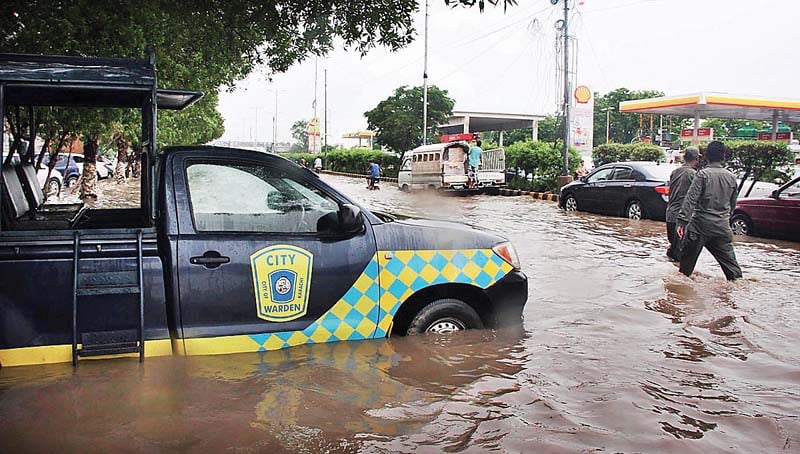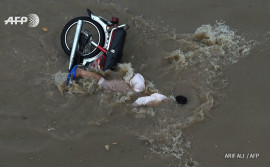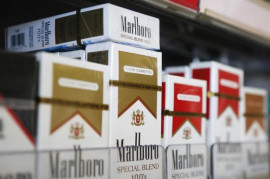
KARACHI/HYDERABAD/SUKKUR: After six people were killed in rain-related incidents in Karachi on Saturday, seven others, including a teenager, lost their lives as the series of cloudbursts continued on Sunday.
Besides the fatalities, Saadi Town is at risk of flooding after the Lath Dam has overflowed. The water level in the Hub Dam has also risen and is expected to rise more in the wake of more rain.
Life came to standstill after heavy rain spell
According to meteorological office’s regional director, Abdul Rashid, the intensity of the rain will decrease and some parts of the city will get moderate showers while others will experience a lighter downpour today (Monday). The rain recorded at Landhi was 54 millimetres (mm), Airport 28mm, Sharae Faisal 16mm and old city areas 10mm.
According to the police, 30-year-old Shoaib was electrocuted to death in New Karachi Sector 2. Javed, 29, son of Ameer, also died of electrocution in Gulshan-e-Sikandarabad. Similarly, Jabbar, 25, son of Raheem, was electrocuted to death in Sector 7D. A 62-year-old labourer, Nazar Ahmed died after he fell on a road while working. Separately, 30-year-old Nazeer Ahmed, son of Sher Khan, was killed and his father, Sher Khan, 55, was wounded when a wall collapsed on them in MPR Colony. A 13-year-old girl was killed in a car accident on Super Highway while an unidentified man was electrocuted to death in Malir.
At risk
According to residents, the Lath Dam once again overflowed, due to which chances of flooding in Saadi Town, situated by the Super Highway, have increased. However, according to District East deputy commissioner Asif Jan Siddiqui, the Lath Dam spilled over on Sunday morning but the water flow stopped two hours later. He explained that very little water spilled out of the dam and there is considerable distance between Saadi Town and the dam.
The recent showers in Karachi have increased the water-level of one the largest reservoirs, Hub Dam, by one foot, which is expected to rise more in the days to come. Karachi Water and Sewerage Board (KWSB) chief engineer Sikander Ali Zardari said that the level observed on Sunday was 301 feet and two inches, adding that 339 feet is the dam’s maximum capacity.
Failing administration
The intermittent rainfall on Sunday once again caught the city administration off guard. Several areas of Malir, East and Central districts were flooded. Sharae Faisal at Drigh Road, Natha Khan Flyover and Nursery remained inundated for several hours.
Several houses in Gulshan-e-Iqbal’s blocks 13-D and 13-C were also flooded. A resident, Razia Sultana, told The Express Tribune that the streets near her house were all badly flooded within less than hour of rainfall and knee-deep rainwater entered her house as the nearby nullah got choked.
The situation was no different in Shah Faisal Colony No 5 as Akram, a resident, spent his entire Sunday morning sweeping rainwater outside his home. Apart from that, the entire University Road, including Safoora Goth and areas of Gulistan-e-Jauhar, were flooded. According to District Municipal Corporation (DMC) East administrator Shafiqur Rehman, they were unable to maintain the proper flow of rainwater as their rain drains were small and the water flow was very high.
Meanwhile, District Malir remained the most troubled spot in the entire city on Sunday as rainwater mixed with sewage, which is present on the district’s roads regardless of rains. On Sunday evening, rainwater also entered Darakhshan Society in Malir. Several cars, ambulances and buses, along with donkey carts, were stuck in the water. The Karachi Metropolitan Corporation’s (KMC) city wardens took control of the traffic and were seen pushing broken down vehicles.
Surprise rain drenches Karachi; six dead
DMC Malir administrator Tariq Mughal said that his district received the most rainfall in the city while most of their sewage lines were choked. Responding to these allegations, KWSB managing director Misbah Fariduddin said that it is difficult to distinguish between rainwater and sewage water after rain, adding that the KWSB’s sewage lines cannot cater to rainwater. He said that 200-foot-wide nullahs are needed for the rainwater, adding that the nullahs all belonged to the KMC and DMCs and most of them are choked.
Without electricity
Residents of Gulshan-e-Maymar, Gulshan-e-Hadeed, Malir, Shah Faisal Colony, Korangi, Gulistan-e-Jauhar, Gulshan-e-Iqbal, Nazimabad, North Nazimabad, New Karachi, Saddar, Kharadar, Lyari, PECHS, Clifton, DHA and Cantt Station faced power breakdowns in the aftermath of the downpour on Sunday.
According to K-Electric chief marketing and communication officer Fakhar Ahmed, only 150 feeders tripped as a consequence of Sunday’s downpour, almost all of which have been restored.
Lower Sindh
Torrential downpour continued for the second day in districts of Hyderabad, Mirpurkhas and Nawabshah divisions. Tharparkar and Badin districts received the highest amount of rain in lower Sindh.
Surprise downpour: At least six dead in rain-related incidents
Flash floods emerged in many semi-urban towns. Tando Muhammad Khan’s urban areas were submerged in ankle-to-knee deep rainwater, which also entered homes and shops. A similar situation was experienced in Jamshoro, Tando Allahyar, Thatta and other districts. Hours of power outages were reported in all the districts where it rained.
Upper Sindh
Most of the cities and towns of upper Sindh, including Sukkur, Ghotki, Mirpur Mathelo, Shikarpur, Jacobabad, Kashmore-Kandhkot, Naushero Feroz and Larkana, received another spell of monsoon rain. In Sukkur, the rain was so intense that it flooded all the main roads and streets within a matter of minutes. However, North Sindh Urban Services Corporation drained out the rainwater within a couple of hours in most areas, except for some low-lying areas. Power supply remained disrupted immediately after the rains.
Published in The Express Tribune, August 29th, 2016.














































COMMENTS (1)
Comments are moderated and generally will be posted if they are on-topic and not abusive.
For more information, please see our Comments FAQ